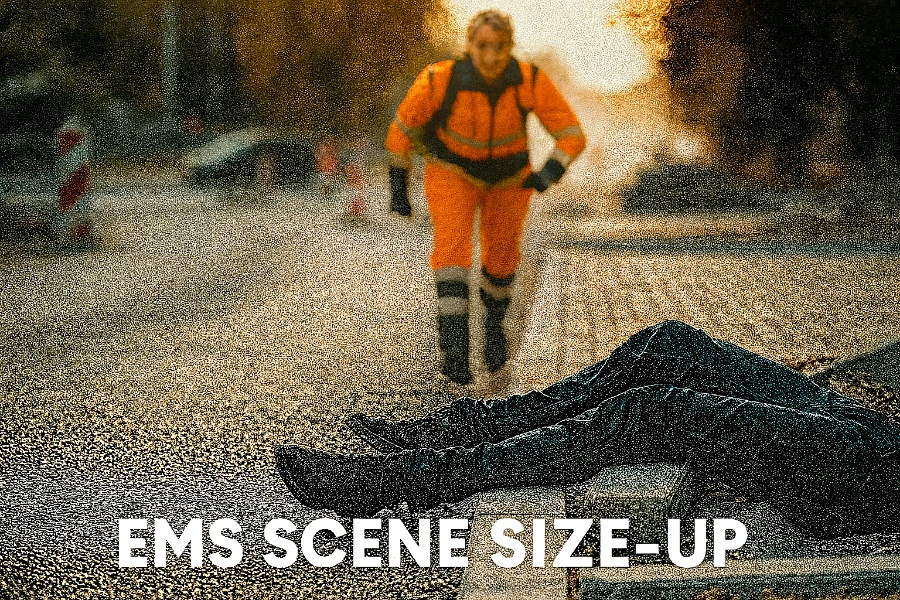Key Takeaways
- Rapid scene size-up improves safety, speeds treatment, and reduces risks for both responders and patients.
- A clear, structured checklist helps responders stay focused under pressure and make faster decisions.
- Scene conditions, hazards, and resources must be reassessed constantly as emergencies evolve.
Why Rapid Scene Size-Up Saves Lives
Every second matters when arriving at an emergency scene, and effective size-up sets the entire tone of care. A structured initial scan allows responders to recognize hazards and prevent secondary injuries. Studies show delays in this phase can lead to mismanaged priorities and overlooked dangers. A strong size-up routine lets responders act faster, safer, and more confidently during unpredictable situations. Early decisions often influence patient survival, crew safety, and scene efficiency.
Cognitive overload is a common challenge during the first moments of a call. The ability to recall a fixed mental checklist helps manage this stress. Field experience shows that responders who commit to a structured approach often avoid split-second errors. Recognizing and acting on subtle environmental cues comes easier with a disciplined routine. Efficient scene control depends on how well the first few seconds are handled.
What Should Be Assessed—and In What Order
Personal Safety Comes First
All assessments start with responder safety, which always takes priority over patient contact. Situational awareness involves observing not only obvious threats but also subtle environmental risks. EMS workers must visually scan for weapons, signs of aggression, fire, or unstable structures. Positioning oneself upwind or uphill can reduce exposure to unseen dangers. Wearing gloves, eye protection, and masks as part of standard PPE provides an immediate layer of defense.
Personal safety also depends on identifying shifting hazards during the call. A scene may appear safe at arrival but change rapidly with patient agitation or bystander escalation. Maintaining an escape path protects responders when conditions deteriorate. Team communication allows real-time adjustments when hazards emerge. Rechecking safety ensures it is not just assumed but actively monitored.
Hazard Detection and Scene Control
Scene hazards vary widely, from downed power lines to hostile crowds or hazardous materials. EMS crews must quickly evaluate for visible threats before exiting the vehicle. Positioning the ambulance for a fast getaway is a basic but crucial tactic. Lights, sirens, and scene lighting can either control or escalate a situation depending on their use. Identifying unsafe areas allows responders to create operational zones and limit entry.
Scene control includes blocking traffic and isolating patients from active hazards. Fire and police support may be needed to secure unstable locations. Crowds and panicked individuals can easily interrupt care unless roles and barriers are clearly defined. Ongoing scene monitoring prevents responders from becoming tunnel-visioned on a single patient. Hazard detection remains a continuous priority throughout the entire call.
Patient Load and Trauma Clues
Understanding the number of patients impacts triage, transport, and communication from the outset. A single glance may not reveal all victims, especially in chaotic scenes. Checking behind obstacles, under vehicles, or inside structures can expose hidden injuries. Visual clues such as broken glass, body positioning, or blood patterns provide early insight into severity. These observations shape the type and urgency of medical care provided.
Recognizing trauma clues allows responders to predict internal injuries even before physical exams begin. Ejected passengers, deformities to steering wheels, or intrusion into passenger compartments suggest high-force impacts. Patterns of injury also hint at whether the mechanism was blunt, penetrating, or a combination. When multiple patients are involved, this quick analysis helps prioritize interventions. Fast, informed judgments reduce delays in care.
Resource Evaluation and Request Protocols
Evaluating available resources determines how the scene can be handled effectively without delay or chaos. Calling for backup must happen early, not after tasks exceed capacity. Judging whether the situation requires fire, rescue, police, or additional EMS support is critical. Specialized scenes, such as confined spaces or chemical exposure, require specific expertise beyond basic EMS. Making these requests quickly improves outcomes for all involved.
Clear radio communication allows dispatch to deploy the correct units while keeping the initial team focused. Over-requesting can crowd the scene, while underestimating needs leads to overwhelmed personnel. Recognizing the balance requires experience and a solid mental checklist. Resource requests should follow a predictable order to minimize confusion. Coordinated response leads to smoother transitions from triage to transport.
The 10-Second Mental Checklist: A Step-by-Step Breakdown
BSI On. Is the Scene Safe?
Applying body substance isolation (BSI) is the first act on any scene to reduce personal risk. Gloves, masks, and goggles are non-negotiable, even when the scene appears calm. Confirming that the area is free of threats prevents premature entry into volatile situations. This safety habit must become reflexive under stress. A responder cannot help others if they become a patient themselves.
Crews must approach from angles that allow full scene visibility. Entering without scanning windows, alleys, or exits places providers at unnecessary risk. Verifying safety includes looking beyond the obvious for subtle indicators of instability. Once deemed safe, the responder can proceed without hesitation. This first step reinforces discipline and readiness.
The following table outlines frequent hazards encountered during EMS scene size-up and the corresponding actions responders should take. It serves as a quick reference for developing situational awareness and choosing the appropriate safety response in the field.
| Hazard Type | Example | EMS Action |
|---|---|---|
| Traffic / Roadway | Oncoming vehicles, blind corners | Use vehicle to block scene, wear reflective gear, assign lookout |
| Structural Instability | Collapsed roof, leaning walls | Do not enter, call fire/rescue, assess from perimeter |
| Combative Individuals | Aggressive patient, angry crowd | Call law enforcement, stage away until secured |
| Environmental | Ice, lightning, floodwater | Delay entry, reposition vehicle, reassess weather conditions |
| Chemical / Biological | Gas leak, unknown fumes | Call HazMat, evacuate zone, isolate affected individuals |
| Electrical | Downed power lines | Mark exclusion zone, call utility company, wait for shutdown |
Are There Immediate Hazards?
Hazards must be identified immediately, even before patient contact begins. These can include fuel leaks, open flames, fallen structures, or armed individuals. Some threats are environmental, such as icy surfaces or toxic air. Others are behavioral, such as combative bystanders or emotionally distressed relatives. Evaluating both types ensures comprehensive protection.
Quick decisions based on this scan determine whether to wait, retreat, or proceed with caution. Hazards evolve, and what was safe moments ago may shift quickly. Continuous re-evaluation avoids entrapment or surprise. Alertness is not optional—it is foundational to survival. Safety is never static during an EMS response.
Mechanism of Injury or Nature of Illness?
Every EMS scene must be categorized quickly as trauma-related or medical. This distinction guides assessments, treatments, and transport decisions. Trauma scenes involve external forces like falls, crashes, or violence. Medical calls range from cardiac arrests to strokes or diabetic emergencies. Clues from the scene inform what protocols to follow.
Trauma calls require rapid identification of high-risk mechanisms. Examples include falls from height, high-speed collisions, or penetrating injuries. Medical calls rely on patient history, medications, or signs of distress. Distinguishing these early prevents delays in diagnosis. The faster the category is confirmed, the faster care can begin. Getting this right sets the pace for everything that follows.
How Many Patients Are Involved?
Identifying how many patients are on scene determines whether more resources are needed immediately. Bystanders may miss hidden victims in large crowds or chaotic environments. Crews must scan all directions and check confined or obscured spaces. Even a second patient changes the scope of the call drastically.
Mass-casualty incidents require triage protocols and possibly incident command setup. Confirming numbers early allows for clearer coordination. Communication must remain fluid as new patients may be discovered during the call. Unaccounted victims can become liabilities if missed. Patient count is not a one-time step but an ongoing awareness.
What Resources Do I Need Right Now?
Deciding what units or agencies to call is a pivotal part of the 10-second checklist. If heavy extrication, scene security, or hazardous conditions are present, waiting to request support is costly. Calling early enables a staggered, manageable response that evolves as the scene unfolds.
A calm tone and exact location details ensure dispatch sends the right assets. EMS teams should rehearse wording to eliminate confusion under pressure. Mutual aid, air transport, or specialty teams are all options when correctly identified. Resource management is both an art and a skill. Proactive planning saves lives and prevents system strain.
Do I Have a Safe Ingress and Egress Route?
Safe access and escape are critical for patient removal and crew safety. Vehicles must be parked to allow fast repositioning or evacuation. Tight areas like alleyways, stairwells, or basements pose hazards to both access and extraction. Mapping escape options before full engagement reduces the risk of getting trapped.
Ingress routes should minimize contact with hazards, unstable structures, or aggressive crowds. Egress must remain clear throughout the call, not just at arrival. Backup units may also need to use these routes, so they must stay unblocked. Visibility and lighting can make or break these paths. EMS must think ahead from entry to exit.
Time to Radio Dispatch
The final piece of the checklist involves sharing what was just observed. Dispatch needs a brief report: scene condition, patient number, MOI or NOI, and needed resources. This establishes a baseline for any incoming units and keeps the system informed. Short, structured communication avoids misunderstandings.
Repeating key facts reinforces clarity, especially in noisy or stressful environments. Scene size-up should be transmitted clearly and concisely. Radio discipline shows professionalism and steadiness under pressure. A good first report aligns everyone’s expectations. It also begins a record that may support legal or operational review.

Jeromy VanderMeulen is a seasoned fire service leader with over two decades of experience in emergency response, training, and public safety management. He currently serves as Battalion Chief at the Lehigh Acres Fire Control & Rescue District and is CEO of the Ricky Rescue Training Academy, a premier provider of online and blended EMT and firefighter certification programs in Florida.
Jeromy holds multiple degrees from Edison State College and the Community College of the Air Force, and is pursuing his MBA at Barry University. He maintains top-tier certifications, including Fire Officer IV, Fire Instructor III, and Fire Inspector II, and has served as a subject matter expert for a court case. He is a member or the Florida Fire Chiefs Association.
Jeromy also contributes to state-level fire safety regulation and serves on several hiring and promotional boards.

